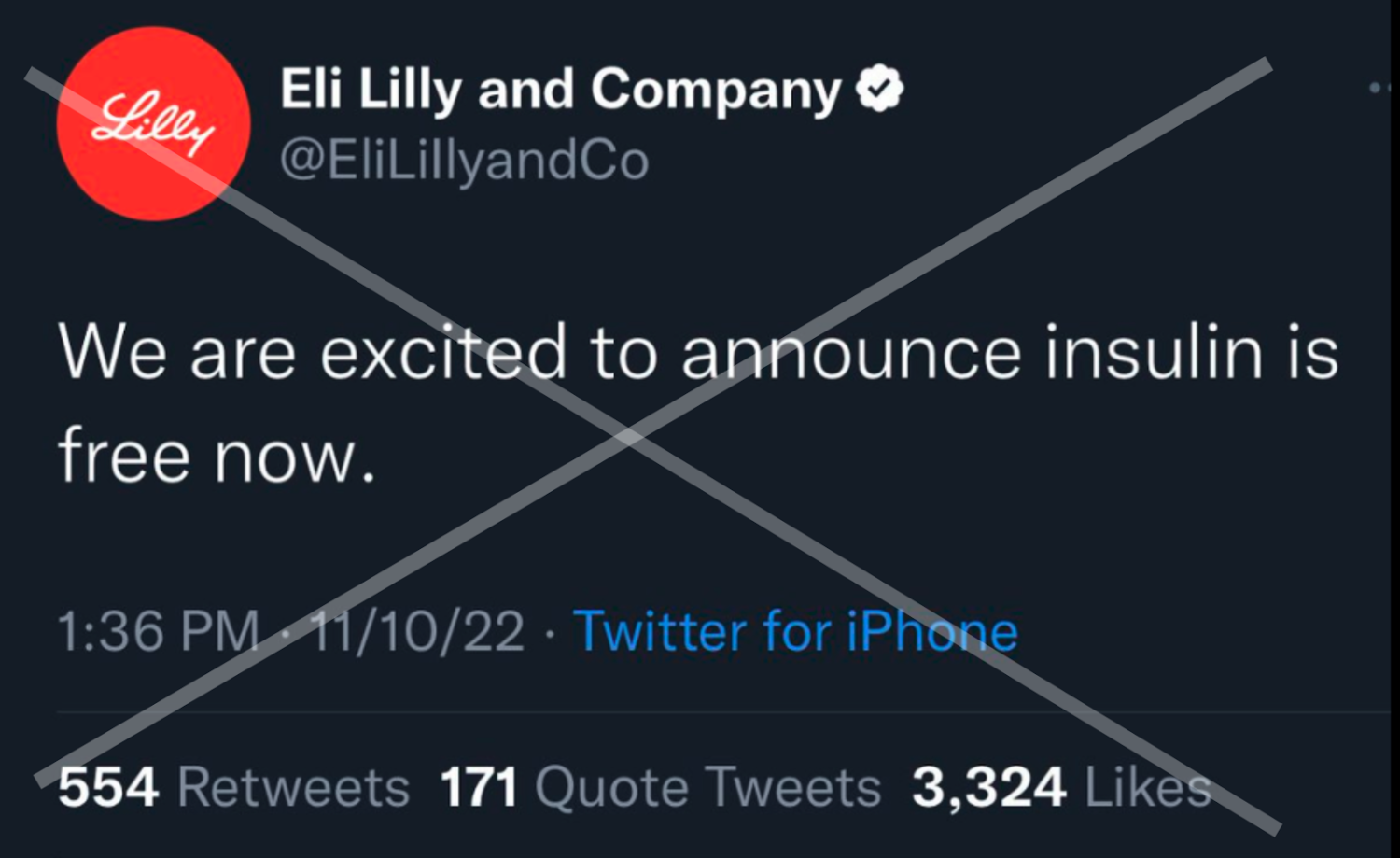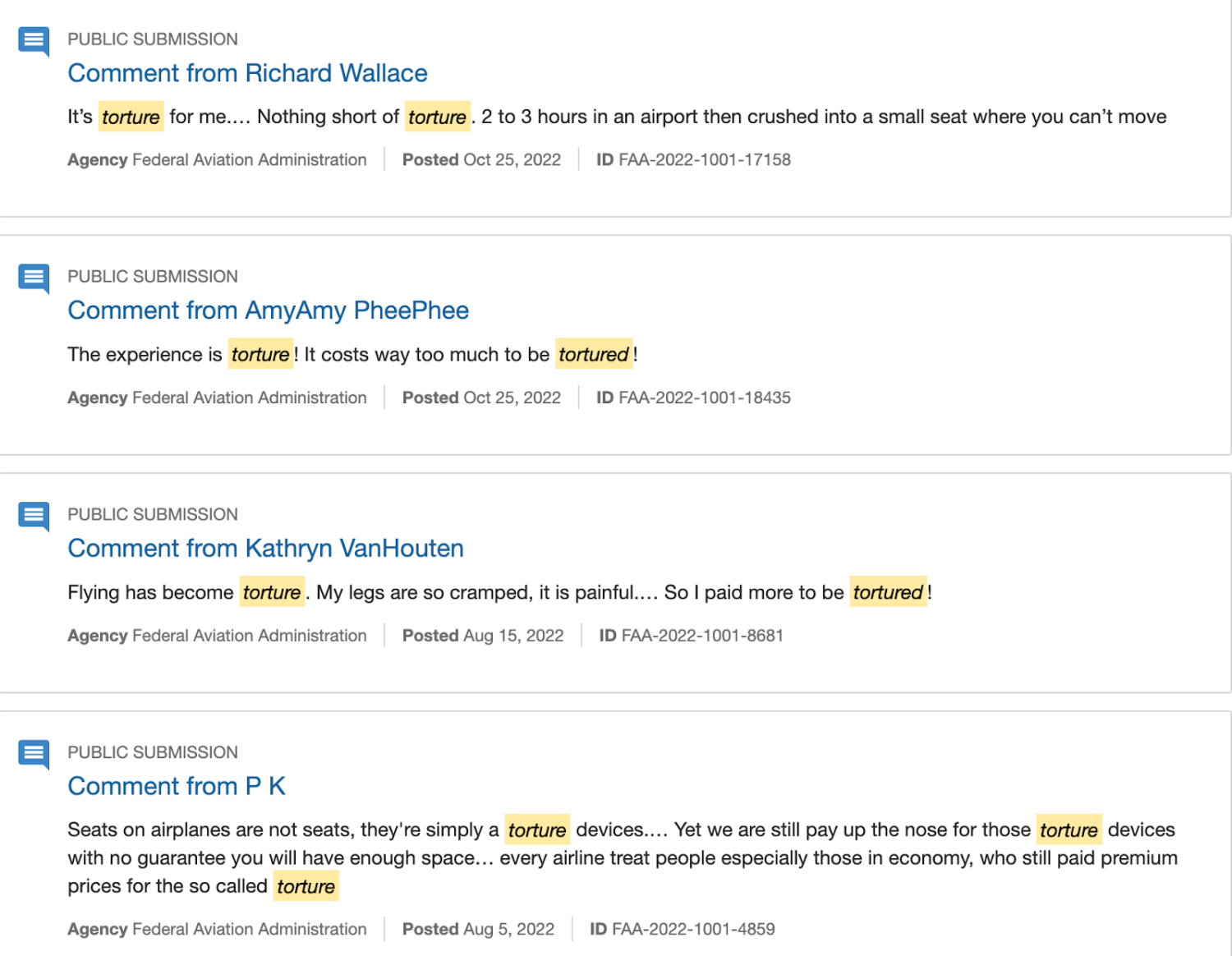
The Morning Meeting with Al Tompkins is a daily Poynter briefing of story ideas worth considering and other timely context for journalists, written by senior faculty Al Tompkins. Sign up here to have it delivered to your inbox every weekday morning.
Somebody posted this fake, but real-looking Twitter post on Thursday that raised the hopes of millions of people who struggle to pay for their insulin. The fake-but-verified tweet was online for three hours and has 1,500 retweets and 10,000 likes.

Al Tompkins drew an X on a fake tweet to discourage people from grabbing it and attempting to keep the lie alive. (Twitter and Al Tompkins)
I suppose this was a double protest against drug costs and Twitter’s new for-pay check mark verification.
Lilly responded:

(Twitter)
The insulin rumor may be part of a battle over insulin prices that Lilly has tried to respond to in recent days. A study by T1 International, found that 1 in 4 people living with diabetes in the U.S. has reported rationing their insulin due to high prescription costs. Another study just published in the ”Annals of Internal Medicine” said more than 1 million people with diabetes in the U.S. rationed their supply in 2021 because of cost.
Lilly responded to recent protests saying:
Lilly is committed to making insulin affordable for all people living with diabetes, regardless of income or insurance status. In the past years, we introduced multiple solutions that have progressively lowered the out-of-pocket cost for Lilly insulin. Today, anyone is eligible to purchase their Lilly insulin prescription for $35 or less per month, regardless of the number of pens or vials they use, and whether they are uninsured or use commercial insurance, Medicaid, or are enrolled in a participating Medicare Part D plan.
The fact is that our solutions are making a real impact for people with diabetes. Despite rising deductibles, the average monthly out-of-pocket cost for Lilly insulin has dropped by 44 percent, to $21.80, over the last five years. Lilly has not increased list prices for any of our insulins since 2017 and continues to take steps to help lower out-of-pocket costs.
You can also read recent statements from the other two drug companies that produce insulin.
7 million Americans should use insulin daily to control their diabetes. This summer, Yale researchers found:
14% of people who use insulin in the United States face what are described as a “catastrophic” level of spending on insulin, meaning they spent at least 40% of their postsubsistence income — what is available after paying for food and housing — on insulin.
All of that background may contextualize why someone would combine insulin and twitter frustrations into one ill-advised protest post.
On Thursday, The Washington Post reported that “Several top privacy and security executives resigned from Twitter on Thursday, citing fears over the risks from Elon Musk’s leadership in a stunning exodus that prompted federal regulators to warn they might step in.”
About the fake verified accounts, the Post reports:
Musk has said the company would suspend such accounts, but a number of fake accounts remained online for hours, receiving tens of thousands of likes and retweets. Early Thursday, in a response to someone mentioning that a fake Biden was talking about performing a sex act, Musk responded with two cry-laughing emoji.
CNN: Twitter is battling a wave of impersonators after launching its new paid verification system by Brian Fung
And on Muck Rack Journalists: This little Chrome extention can help you tell the difference between actual verified accounts and twitter blue users. Just install the extension and see the difference. Made by Will Seagar and Walter Lim. For the moment it is a “developer” extension but when it is approved it will be even easier to install.
The link will walk you through the installation process and help you to spot the difference between tweets like these:

(Twitter)
Railroad strike deadline delayed — now Dec. 9
There is a glimmer of hope today that Americans might avoid a national railroad strike. The third largest of 12 unions that are voting on a new contract with railroad companies agreed to a “cooling off” period that starts Nov. 20 and lasts until Dec. 4.
The Brotherhood of Maintenance of Way Employees Division of the International Brotherhood of Teamsters rejected the recent labor deal brokered by the Biden administration.
A number of trade associations, including the American Trucking Associations, the National Retail Federation, the U.S. Chamber of Commerce, the American Farm Bureau, the International Association of Movers and the International Bottled Water Association, are pleading with President Biden to get involved again to prevent a national railroad strike. The President cannot prevent a strike, but Congress can.
All of this may sound familiar. On the eve of a strike set for September, the unions and railroads came to a tentative agreement brokered by the Biden administration. But so far seven of the 12 main rail unions, including two of the largest, have agreed to the proposal. Two more rejected it and three will vote on the agreement soon. Over the weekend, 52% of the International Association of Machinists and Aerospace Workers voted for the new contract that includes 24% raises and $5,000 in bonuses. But all 12 of the unions must agree to the contract to avoid a strike.
The letter from the trade associations says:
We are writing to you today urging you to continue to work with the railroad unions and railroads to ensure that the tentative agreement that you helped broker is ratified by the parties.
“It is paramount that these contracts now be ratified, as a rail shutdown would have a significant impact on the U.S. economy and lead to further inflationary pressure.”
Unfortunately, we have seen two unions reject the agreement and there are concerns that others may follow. If that were to be the case, we could witness a strike that would shut down the entire freight rail system. Because the White House played such a central role in the process, we believe it can be helpful in continuing to move the process forward in a positive direction.
The head of the Brotherhood of Maintenance of Way Employees Division union that rejected its agreement earlier this month said if the railroads won’t consider adding sick time he has no choice but to prepare for a strike next month. Union President Tony Cardwell said railroad executives continue to “bow to Wall Street’s continued desire for more than its fair share” as they report billions in profits.
JDSupra points out why railroads are so critical to America’s supply chain.
Today, railroads account for 27% of freight deliveries as of 2020. Their pervasiveness across the United States makes them an ideal form of transportation to deliver goods for longer distances than any other mode. Second only to truck transport for ton-miles comparison in the U.S., each bulk and merchandise train can carry a load of up to 500 trucks. In fact, freight trains can move one ton of freight over 450 miles on a single gallon of fuel. This makes them more efficient for the transport of products.
These are the major railroad corridors in the United States. Think of them like superhighways for trains.
Remember, trains today are just a part of the intermodal way of transporting goods which includes barges, trucks and trains.
OilPrice.com points out that while we might think of trains as a way to move things around America, they are a key way to move American products to the world.
Roughly ⅓ of all US exports rely on freight transport. Food, wood, coal and metal all move across the US’ 140,000 miles of freight routes. Because of this, many US goods providers are worried about the possibility of yet another major railway strike.
In September, two of the 12 major US railway unions rejected negotiations, putting a potential strike back on the table this winter. This latest steel news has buyers and sellers wondering: what does this mean for metal?
About 52% of all US freight cargo consists of bulk commodities. For instance, coal, iron ore, and scrap steel are three common freight goods transported around the US daily. This also includes coking coal used to produce steel. Therefore, America’s steel mills are particularly dependent on the railway systems’ ability to transport these items on-site. Should a strike ensue, it would mean big trouble at an already-sensitive time.
Airline passengers flood FAA with 26,000 complaints about airline seats
The FAA asked what you have to say about airline seats and people unloaded their frustrations.
Big airlines have reduced their seats in coach to 17 inches from 18.5 inches, and they have reduced how far seats can recline too. The FAA does not regulate comfort, but it is interested in whether the smaller seats could cause a safety problem if people have trouble getting out of them in an emergency. In its latest finding, the FAA determined today’s smaller seats are not a safety issue.
I put some search words in the FAA website to get a sense of what some people wrote. Hundreds mentioned the words “torture” or “discomfort.”


(FAA)
A quick civics lesson: how the speaker of the House is chosen
If the GOP becomes the majority of the U.S. House of Representatives, we would (probably) have a new House speaker. But the rules about how a speaker is chosen may surprise you.
For one thing, you do not have to be a member of the House to be speaker. Members have to nominate the person, but in theory, they could nominate you. It says so, right there in Article I, section II of the Constitution that the House “shall chose their Speaker and other officers.” Nonmembers including Colin Powell have been nominated. Never chosen but nominated.
After the nomination, a person needs a majority of the votes from House members who are present and voting. If all of the members were present, a nominee would need 218 votes. Typically votes fall along party lines so whoever is the majority lines up behind one person and selects one of their own. In 1849 the House had been in session 19 days without being able to elect a speaker because no candidate could corner a majority of the votes cast. Finally, after the 59th ballot, the House adopted a resolution declaring that a speaker could be elected by a plurality. Howell Cobb of Georgia eventually was elected speaker but resigned from his government job to join the Confederate Army where he became a general.
There was, for a brief time, a term limit for speakers, but that has been repealed. Each term lasts two years, the length of each session of Congress. And, by the rules of the House, “The Speaker’s role as presiding officer is an impartial one, and his rulings serve to protect the rights of the minority.” That passage is noteworthy because the Speaker’s job is so overtly impartial, and the phrase assumes the speaker is a man.








